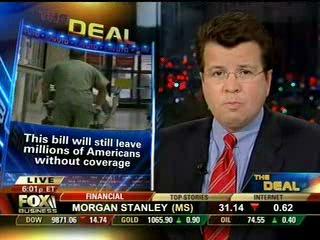Assessing Fox Business Network, Two Years Later
 Fox Business Network celebrated their two-year anniversary last week, and with the addition of Don Imus, the FBN brand has been discussed more recently than at any other time in the young channel’s history.
Fox Business Network celebrated their two-year anniversary last week, and with the addition of Don Imus, the FBN brand has been discussed more recently than at any other time in the young channel’s history.
After talking to dozens of people who work or have worked at FBN, work at other business networks, or are part of the financial community, we’ve broken down where the network stands, two years in.
Ratings: The debut of Imus in the Morning from 6-9amET has brought big ratings from day one, with 177,000 total viewers, but just 9,000 in the A25-54 demographic (and 73,000 in the A35-64 demo). For the week, the show averaged 148,000 total viewers.
But we’ll get back to the I-Man later.
The last time ratings were leaked before Imus joined the network was August, and the average was around 21,000 during the “business day” – 5am-9pmET (with Imus’ strong debut ratings, the average has reached as high as 60,000). In prime time the number was a little higher, and it was a little lower during the morning hours. With Imus factored into the average, that total viewer average has likely received a big bump. But one area that is clearly still incredibly low is the A25-54 demographic.
And the A25-54 demo is one that advertisers look at as well, compounding the need to improve the ratings in that category. But FBN Executive Vice President Kevin Magee told Mediaite, “I’m not terribly worried about that. The fact of the matter is they are improving, they may not be as quickly as you may think, but we’re doing fine.”
Still, Magee says the network does sell against the rating category. “We do any number of ways, and one of them is the demo, but smarter ad buyers understand that 25-year-olds are great for buying car stereos, but don’t invest a lot,” he said.
That may be – but 50-year-olds do. And one thing Imus’ first day numbers showed is that the wide array of viewers that make up the 25-54 demographic are not being reached very well. With 177,000 total viewers, just 9,000 were in the 25-54 demo. 73,000 are in the 35-64, which means 64,000 come from the 55-64 category. Assuming the under 25 crowd is minimal, that means 95% of the viewers were 55 and older. For the Imus numbers, that percentage is likely to be much higher than the rest of the day, but only because the total viewer is so high – in fact the key demo number is likely to be lower for most of the other business day programs.
A business news insider tells Mediaite, “There’s no one out there that could have predicted their number would be this low, for this long, unless they watch on a regular basis.”
Still it’s important to remember a few factors – the demographic viewer number is very likely to be the last category to see significant growth. While Fox News, which celebrated its 13th birthday last week, was able to surpass CNN in some categories after four years, it took more than five years to beat CNN in the demo. And sticking with Fox News, a network that is now so dominant over the rest of the cable news landscape, let’s take a look at how that network was performing after its first two years. For October 1998:
CNN – 430,000 total viewers, 116,000 in A25-54
MSNBC – 150,000 total viewers, 56,000 in A25-54
FNC – 79,000 total viewers, 27,000 in A25-54
While Fox News was certainly doing significantly better than FBN is, the network was far behind industry leader CNN at the time. And FNC, a general cable news channel, has a wider appeal in general than the more niche FBN. Bloomberg, which has been around a lot longer than FBN, averaged 63,000 total viewers and 19,000 in the demo during 5-8amET during December 2008, in numbers obtained by Mediaite. These numbers are better than the general Imus-free FBN show, but not by much.
So are the ratings that bad? Well they aren’t good – the demo number is incredibly low and the total viewer average has a ways to go. But Imus will continue to help significantly (again, much more on this later). And it’s important to keep things in perspective, when looking at the still very young network.
>>> NEXT PAGE: Financial community reach and network ‘in-fighting’




